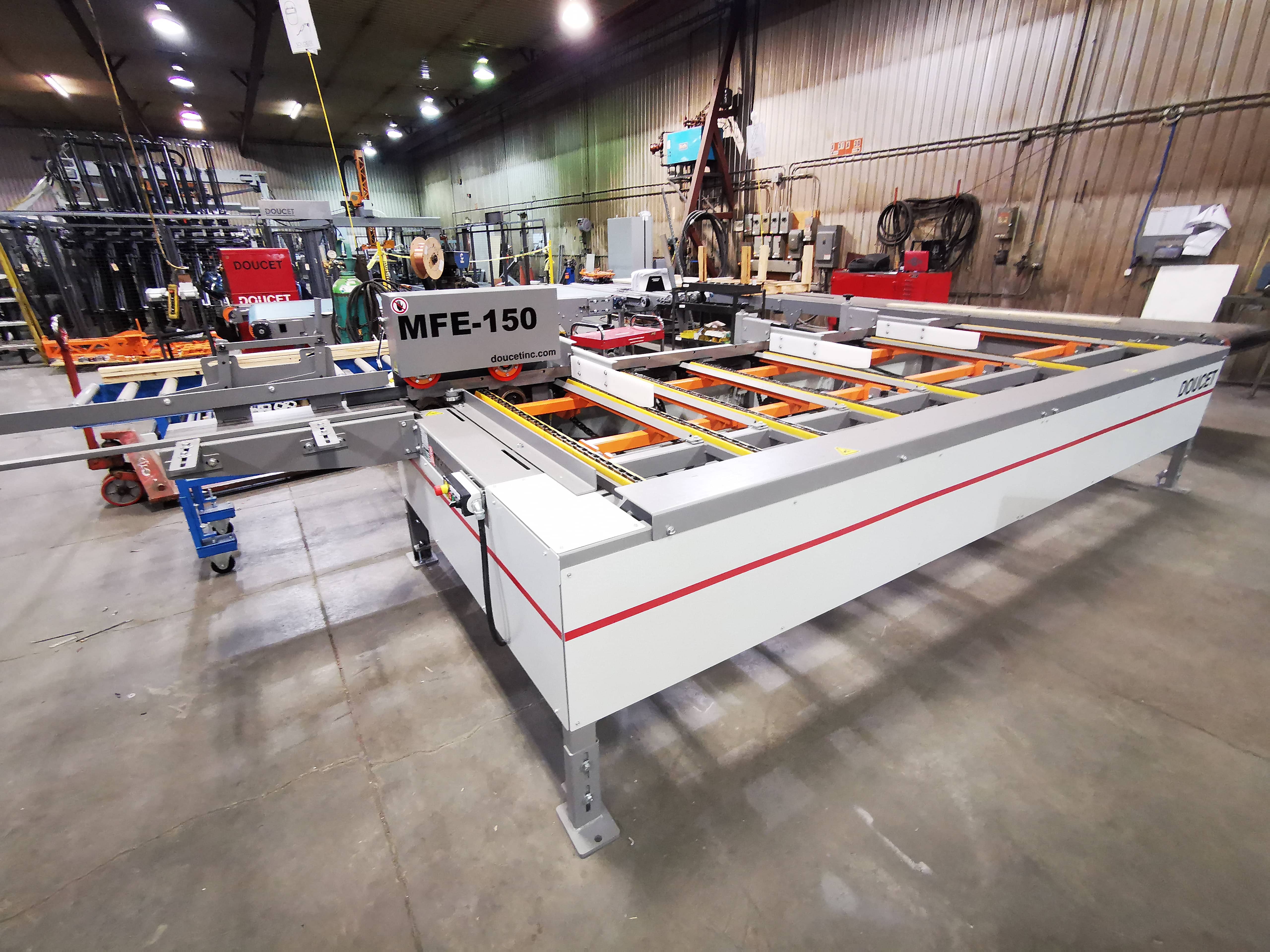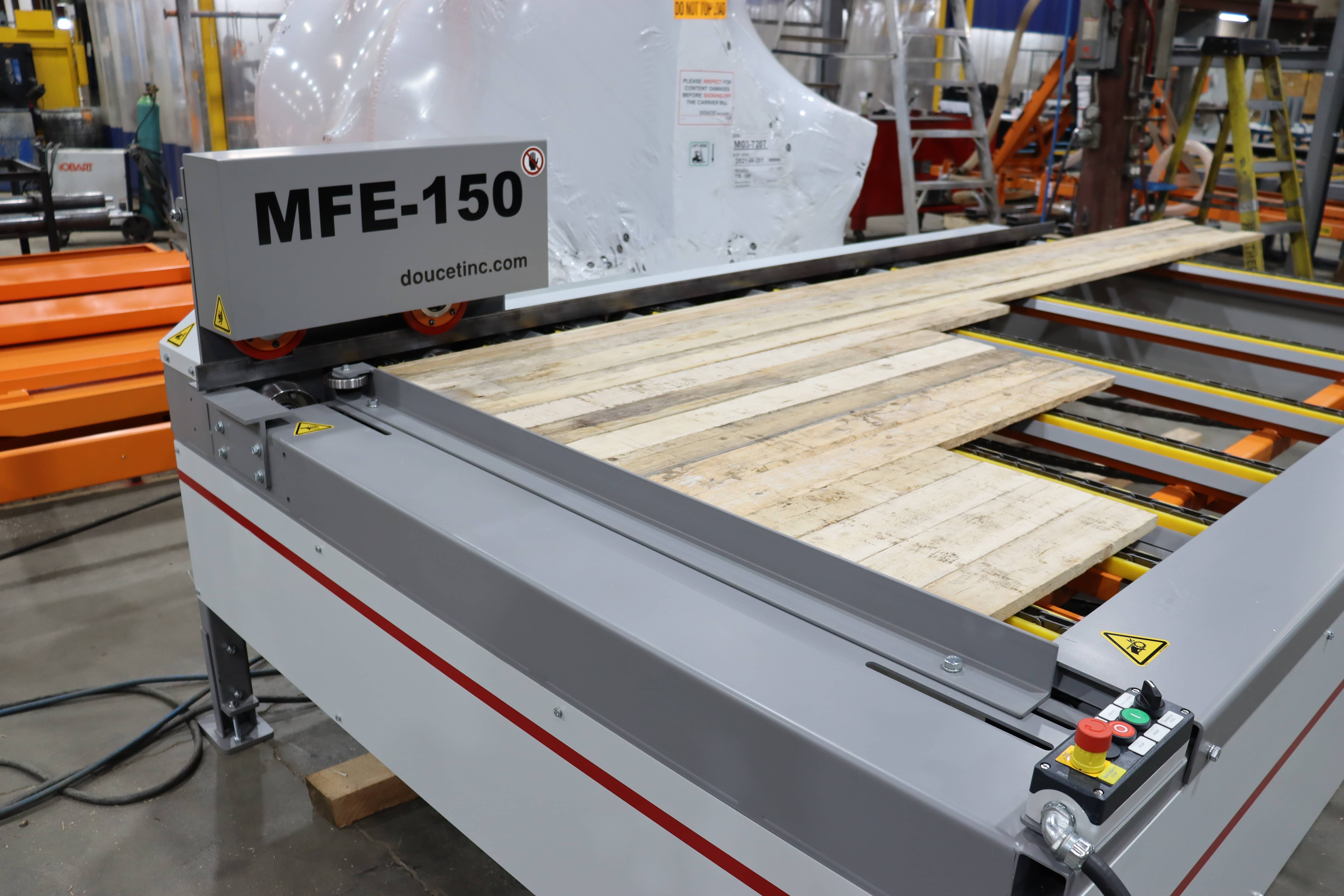You are already anticipating your next meeting with the executive team... At each meeting, they add a layer of pressure, bombarding you with questions about your moulder's productivity rate, which has been unstable for several months. The bosses are unanimous, they don't understand..." Why are we unable to keep an operator at the feeder station of the moulder? Why is our production going up and down? What is the problem? What are the solutions?"
Be reassured, most manufacturers in the woodworking industry face this problem at one time or another. Feeding a moulder quickly, efficiently, and consistently is almost impossible for a human. It is an extremely difficult task physically and not very gratifying. I know what I am talking about, I have operated moulders myself. Since then, I have managed several manufacturing companies, in addition to helping others optimize their production. With this article, I simply want to share my knowledge and experience on the subject.
If the moulder feeder is currently on your wish list, you will find in this complete guide on the MFE-Lateral Chain Feeder for Moulders, everything you need to know to guide you in your decision. From technical features, to benefits, to whom the MFE-Lateral Chain Feeder for Moulders is made for, to costs, to questions to ask yourself before making a purchase. It's all here! You will be fully prepared and in control for your next meeting with the board!
Table of contents
Description
Who is the moulder feeder made for?
Main question to ask before purchasing
Costs
Return on investment
Product Description
The MFE-150 Lateral Chain Feeder for Moulders is designed to maintain a feed rate of up to 150 feet per minute of material of fixed or varying lengths in a moulder, while the MFE-300 maintains a feed rate of up to 300 feet per minute.

Learn more about the technical specifications and options of Lateral Chain Feeder MFE.
For whom is the Lateral Chain Feeder for Moulders made (or not made)?
Firstly, the MFE is a moulder feeder, so it is for the woodworking industry and therefore, for all manufacturers who own this kind of equipment.
More specifically, you should pay attention to two indicators that could confirm that it is time to invest in a moulder feeder.
- The operators' physical capacity: feeding a moulder is a very difficult job physically, it is also a job that is susceptible to a high turnover rate. So, you are constantly looking for people to feed the moulder.
- If the volume of your production is not maximized, perhaps it is at the in feed of the moulder. This would be the bottleneck at this station.
For whom is the MFE-Lateral Chain Feeder for Moulders not for?
Although the MFE-Lateral Chain Feeder for Moulders is designed for all manufacturers in the wood industry, it should be noted that the small cabinetmaker, who produces "custom" on a small scale, will not need this type of moulder feeder.
What are the questions you should be asking yourself before purchasing a moulder feeder?
What is the speed of your moulder? (feet/minute)
How fast are you producing now? Is your operator keeping up? Is he performing? Are you achieving the desired productivity now? It is important to understand that the MFE-Lateral Chain Feeder for Moulders solves existing and current productivity problems, with the objective of improving the performance of the moulder and its operator.
What level of speed would you like to achieve in the middle and long term? (Today's production + how much?)
What are your objectives? Do you want to increase your production by 50% in the next year, by 100%? If so, will you be able to sell your stock? Do you have the resources to manufacture your products? In other words, will you be able to support this increase in production?
You need to think now about the next steps to plan for the new bottlenecks that will be created. The addition of a moulder feeder will have a direct impact on the entire production line, which is why it is essential to plan for the next few years in anticipation of the desired increase in production.
If you are planning to change your moulder in the short or midterm, it is better to plan now for the right feeder, so that it will be able to support an increase in output speed.
What type of materials do you use?
Generally, your moulder must manufacture wood mouldings, but sometimes some of our customers work with recycled plastic, for example! To better guide you in your choice of feeder, it is essential to know the type of material used.
- Hardwood
- Softwood
- Planed wood
- Other
What are the smallest and largest part sizes handled by MFE-Lateral Chain Feeder for Moulders?
In terms of minimum width, we have recently tested up to 1". However, such a narrow range is not considered a standard size and requires a surcharge for the addition of pressers to stabilize the parts.
As for the maximum width, it is directly related to your moulder's capacity. Usually, the machine can handle anything the moulder can handle!
As for lengths, the MFEs are designed to work with 3', 8', 12' and 16'.
If you are dealing with non-standard part sizes throughout your production, there are several solutions. We are used to advising manufacturers towards the right choice of equipment.

Will the MFE-Lateral Chain Feeder for Moulders damage your material?
If you need no marks or scratches on your parts, simply mention to us your requirements and we will choose the right wheels for your type of wood. For example, a soft wood might need a set of smooth urethane wheels instead of steel.
Note that the choice of non-standard wheels is one of the options that can have an impact on the total price of your moulder feeder.
Will the MFE be compatible with my moulder?
Yes, it will! Doucet can adapt to all types of moulders. That's why one of the first steps is to let us know your requirements, including the details of your moulder, which will allow us to manufacture a unique piece of equipment that will benefit your cell.
How much does an MFE-Lateral Chain Feeder for Moulders cost, and what are the factors that impact the price?
The two main factors that determine the price of the MFE-Lateral Chain Feeder for Moulders are the speeds, and the moulding lengths (8' 12' and 16'). There are two categories, the MFE-150 which is designed to maintain a feed rate of up to 150 feet per minute and the MFE-300 which maintains a rate of up to 300 feet per minute. The former has a higher production capacity and is more robustly built.
The length of the deck, which allows the operator time to place the material and ensure quality control, also has an impact on the machine's price. The standard MFE-Lateral Chain Feeder for moulders is 3 feet, but most manufacturers prefer to add 2 to 5 feet. It's possible to add extra feet to customize the machine, it will cost about $1000 per additional foot.
Extending the lanes also allows you to optimize production by adapting the machine to the desired production volume. This will give you time to catch up on your parts! This option varies between $1650 and $3800 depending on the type and length.
The choice of wheel sets and chain plates for the different types of softwood, will also have an impact on the price.
With all the different possibilities to make your MFE-Lateral Chain Feeder for Moulders unique for your application, it is difficult to give you an exact cost here. To give you a better idea of the costs, here is a price range that reflects the average of our projects.
MFE-150
For a standard project, with a few extra feet of decking, we can expect a project between $27,500 and $35,000 on average.
MFE-300
For the 300 models offering more production capacity, also including a few extra feet of deck, we are talking about a project from $34,000 to $48,000, on average.
I would also like to take this opportunity to tell you about the MANYX, which can be added to the end of the MFE-Lateral Chain Feeder for Moulders to automate your cell. It is a stacker/de-stacker that feeds the boards automatically. Compared to an operator who processes one piece at a time, the MANYX handles a series of mouldings at the same time, thus increasing production capacity.
What is the return on investment (ROI) of the MFE-Lateral Chain Feeder for Moulders?
Most manufacturers working full time with their MFE-150 for example, have a return on investment between 6 and 12 months.
The gain is mainly on productivity! Indeed, the machine processes between 15 and 35% more parts while giving the operator time to choose the right side of the panel to maximize the product quality. In short, you will process more panels while reducing the pressure on the operator and increasing the quality of the finished product!
Now that you know if the moulder feeder is right for you, that you know its advantages, its features, its options, its price, as well as the right questions to ask yourself before making your decision, your file is finally ready for your meeting with the executive! With an estimated return on investment of 6 to 12 months, the moulder feeder is an easy addition to your cell that will increase your production capacity by up to 50%.
You might think, "I understand Pascal, but we have many investments to make over the next few years, the feeder is on our wish list, but often outpaced by other equipment! " Right! I don't have the full picture of your operations, but I do hear success stories from our customers every week about their productivity gains with the addition of the MFE-Lateral Chain Feeder for Moulders and I am impressed every time!
What's next? Contact the Doucet sales team to discuss your needs and confirm your potential productivity gains. Doucet is a North American leader in the design, manufacturing, and integration of advanced solutions for secondary wood processing companies.
All our products are designed and manufactured to fit your environment. Contact us for more information!
For your convenience we have 3 ways to contact us:
- Complete the “Request a quote” form online.
- Via Email: info@doucetinc.com
- Or call us at: 1-866-673-8876

